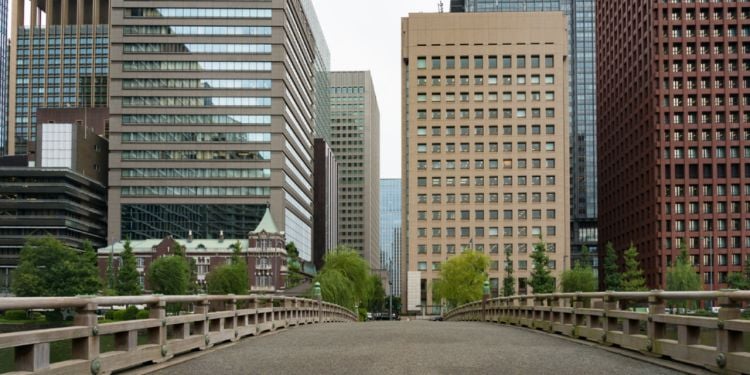
Tokyo and its special wards are fascinating. Each of them has its own identity, and you will find yourself not in front of a single capital but in the heart of a multifaceted city. Here is an overview of Tokyo's most popular neighborhoods.
Central Tokyo
Ginza
Just like Omotesando, luxury is omnipresent in Ginza. World-famous designers have shops in the area. The Ginza area in Tokyo is known as one of the top shopping districts in the city, with a wide range of commercial facilities and a mix of domestic and international luxury brands. Along with these brands, there are also traditional brands that have been cherished for many years.
In addition to shopping, Ginza offers a variety of art galleries and gourmet spots.
To assist new visitors, tourist information centers are located throughout the area, including "G Info" on the first floor of Tokyu Plaza. On weekends and public holidays, a section of the main street, Ginza Chuo-dori, is closed to vehicles, creating a pedestrian-friendly environment where you can relax and enjoy the vibrant atmosphere of Ginza.
Useful link:
Akihabara
Akihabara, also known as “Akiba”, is a popular spot where anime and manga enthusiasts gather. It also has a variety of electronics stores. Besides its otaku culture, Akihabara is close to tourist spots like Asakusa and Ueno, offering unique cafes and shops specific to the otaku community.
Initially known as the electronics ward, Akihabara has become, over time, the den of manga-anime pop culture. The district offers many mangas, DVDs, figurines, cosplay clothes, and collector's items.
These places have become famous, like the tower occupied by the Mandarake firm, which specializes in manga, DVDs, video games, figurines, and other items related to pop culture. Equally famous is the Super Potato store, which is dedicated to video games from the old days. In the past, the shop sold them at attractive prices. Super Potato became known to enthusiasts and the general public. While prices have risen significantly, trade has the advantage of offering items that are difficult to find anywhere else.
During weekends, the main road is closed to cars, allowing pedestrians to roam freely in the neighborhood. Inhabitants and tourists come in large numbers (especially when the weather is fine) for a walk, a moment of relaxation, and in a good mood.
Useful link:
Northern Tokyo
Ikebukuro
Ikebukuro, located in northern Tokyo, offers a wide range of spots that are perfect for a family outing or a romantic date. Places like Sunshine Aquarium and Namja Town are also safe and enjoyable for children.
If you're planning a trip with friends, you can indulge in some shopping at Seibu Ikebukuro Main Store and Tobu Department Store Ikebukuro, or explore the rich history and culture at the Ancient Orient Museum.
Ikebukuro West Exit Park, in front of Ikebukuro Station's West exit, is a spot for enjoying performing arts and relaxation. Tokyo Metropolitan Theater, a top theater in Japan, hosts concerts, plays, dance performances, and more. The nearby open-air Global Ring Theater holds live music and various festivals occasionally. For rakugo, visit Ikebukuro Entertainment Hall. “Rosa Kaikan” and “Shin Bungeiza” show a variety of films, from domestic and international classics to independent films. Nishi-Ikebukuro is where you can find the famous building “Jiyu Gakuen Myokokan” designed by Frank Lloyd Wright. Zoshigaya Kishimojindo Temple in Minami Ikebukuro is a popular spot for praying for safe childbirth and child-rearing.
Ikebukuro is also “the mini Akihabara”. It is situated on the East side, not far from Sunshine city. A long street is entirely dedicated to manga, anime, figurines, cosplay, and other pop-culture items. You can take a refreshing break at the Ikemen café, the “maid café” in the boys' version: here, handsome young men (“ikemen” means “handsome boy”) do the service. Female clients are treated with respect. In this part of Ikebukuro East, pop culture is combined with femininity. From manga shops (Mandarake) to figurines and other accessories (Animate), passing through the Ikemen café (Ikebukuro Boys BL Gakuen) is a delightful experience for customers.
Useful link:
Ueno
A green area in the middle of the skyscrapers, Ueno is especially appreciated for its large park, one of the oldest in Tokyo. It is a garden with a rich history and a hub of culture and art.
In 1868, during the Meiji era, the shogun Yoshinobu Tokugawa abdicated, and the emperor regained full power. The samurai lost their privileges. Protests and rebellions broke out. Some two thousand samurai, who remained loyal to the shogun, decided to take refuge in Ueno and fight against the emperor; they lost the fight.
The museums in the district portray history. For example, the Tokyo National Museum, Japan's oldest national museum (opened in 1872), traces the history of Japanese art – the oldest works dating back to prehistoric times. Ueno also lodges Japan's oldest zoological garden.
Near the station, Ueno Park houses an art museum, Shinobazu Pond, a temple with a five-storied pagoda, and Ueno Zoo. The park boasts seasonal flowers like cherry blossoms in spring and pink lotuses in summer, and visitors flock to see them. Ueno Zoo is home to giant pandas, gorillas, tigers, elephants, and polar bears.
Ueno Ameyoko Shopping Street is bustling with shops and vendors next to the railway tracks. The street stretches approximately 500 meters, with diverse shops offering fresh produce, cosmetics, fashion, jewelry, and more.
The Ameyoko Center Building, situated in the heart of the shopping area, houses various specialty stores that sell different types of spices and herbs. You can also try street food dishes named after the pandas, such as panda yaki, panda bread, and panda bento.
Art enthusiasts can explore galleries and museums like the National Museum of Western Art and the Ueno Royal Museum, showcasing works by renowned artists.
Useful link:
Eastern Tokyo
Asakusa
Asakusa, situated in Taito Ward, Tokyo, offers authentic Japanese culture through its historic shrines, temples, and traditional Japanese food. During the Edo period, Asakusa was known for its entertainment venues, such as showhouses and kabuki theaters. Today, it still retains its cultural charm with places like Asakusa Entertainment Hall.
Asakusa is most often associated with Sensoji, the oldest Buddhist temple in Tokyo. Asakusa has become the ward of tradition, and Japan of former times followed the example of the Edo Shitamachi Dentô Kôgeikan Museum, which exhibits historical objects.
Another piece of art coming straight from Edo is the rakugo. The Asakusa Engei Hall Theatre offers rakugo, Japanese litterature. Literally, rakugo means "story ending with a humorous fall". Alone, in front of his audience, the storyteller discloses his story. In another way, we can say that the rakugo is the ancestor of the one-man show!
There are many shops in Nakamise, the main street of Asakusa. They offer traditional pastries, other typical dishes, and souvenirs in the traditional Japanese way.
Asakusa also offers entertainment through Hanayashiki, Japan's oldest amusement park (created in 1949). Though the park is small, it has a corner for children, and the ambiance is family-centric. It also has a vintage essence that correlates with the surroundings.
The iconic Tokyo Skytree is also nearby, offering a blend of Japan's past and present. Don't miss out on the souvenir shops selling unique Japanese crafts when you visit Asakusa!
Useful link:
Western Tokyo
Shinjuku
It represents all Tokyoite-style diversity on its own. More than a district, Shinjuku is a group of areas where each of them has its unique characteristics. Passers-by meet in the huge station. It is a real cultural experience! Shinjuku station is the busiest in the world.
West Shinjuku: the business area
Quiet and modern, this area is mostly frequented by the ‘salaryman' - the name given to the Japanese employees. Shinjuku West accommodates Tokyo's impressive city hall. The building, better known as the "Tokyo Metropolitan Government Building", quickly became a potent symbol of Tokyo and that of Japan too. Its unique architecture (the building is made up of two high towers, rising like arrows) makes it easily distinguishable.
Shinjuku is the district of hyperconsumption
There's lots of entertainment, shops, restaurants, music, and constant noise. The audience itself is changing: it is getting younger and more colorful.
Kabukicho: the city that doesn't sleep
A few steps take you to the other entertainment district. Kabukicho indeed reveals itself at night. It is one of Tokyo's hot spots, with bars and other host clubs. Kabukicho is also known to be frequented by the yakuza, the Japanese mafia. You can easily walk around the neighbourhood though the atmosphere is sometimes oppressive. Be careful not to get caught up in any bar or club.
South Shinjuku: consumption in a chic version
There are shops and consumption, in a less noisy spirit than that of Shinjuku is. South Shinjuku is best known for its “Southern Terrace”, a wide commercial alleyway located in the open air.
Shinjuku gyoen: the green bubble
It is one of the largest gardens in Tokyo, where Japanese, English, and French styles blend. Especially famed in autumn (kôyô season, Japanese maple leaves) and spring (sakura season, Japanese cherry trees), Shinjuku gyoen offers a calm, soothing break far from the city's hustle and bustle.
Useful link:
Nakano
A little more discreet than the other districts, Nakano cultivates a small village atmosphere. A village that nevertheless hosts the gigantic Nakano Broadway, a commercial zone dedicated to entertainment, shopping and leisure, and above all, a considerable area faithful to manga-anime and pop culture. The area has begun to compete with the very famous Akihabra district, although Nakano Broadway is still not visited by a lot of tourists.
Nakano Zero is another zone dedicated to culture. It is in Shin-Nakano that the imposing building was built, bounded by the Momijiyama Park. It includes a planetarium, rehearsal rooms (dance, yoga, music, etc.), audio-visual space, auditorium, etc. Many students come to train at Nakano Zero, not hesitating to rehearse in front of the building itself or around Momijiyama Park. Numerous concerts and shows make Nakano Zero one of the new sanctuaries of culture.
Useful link:
Shibuya
The busy scramble crossing in front of Shibuya Station is a famous landmark in Tokyo. The crowd of people crossing the street when the traffic lights change and the digital screens showing videos are typical scenes of Shibuya. It's fun to blend in with the crowd, but another way to experience Shibuya is to admire the view from a cafe on the upper floor of a nearby building.
In addition, Shibuya has always been a trendsetting city for young fashionistas with a wide range of facilities, from SHIBUYA 109 Shibuya Store, a popular spot for fashion-forward individuals, to high-rise complexes like Shibuya Hikarie, which houses famous brands and department stores such as Seibu Shibuya Store.
Exploring the unique select shops in the Jinnan area, just a short walk from Shibuya Station, is also a great idea. Besides fashion, you can also discover carefully curated household items at Hands Shibuya Store and Shibuya Loft.
Useful link:
Harajuku
The area is famous for Tokyo fashion, alternating between rock, gothic, streetwear, kawaii (cute, in Japanese), pop, punk, avant-garde, etc. All genres meet in the main street of the district: Takeshita-dori. The street, which is always crowded, brings together tourists and locals in a friendly atmosphere. Colors are everywhere: on clothes, shop fronts, even sweets, pancakes (being the best-seller) offering many flavors: chocolate, with cream, bananas, strawberries, etc. A famous Tokyoite proverb says, "There is no leaving Harajuku without buying a pancake".
The district has a different face which is more calm and meditative. At the exit of Harajuku station, a stone's throw from Takeshita-dori, there is room for meditation at the Meiji-Jingu Shinto shrine. It is built in the heart of the great imperial garden that bears its name.
A few steps away is another park: Yoyogi. It has large pools, a vast lawn, wide alleys, benches, and other amenities that make it ideal for relaxing.
Useful link:
Omotesando
Back to fashion, but this time on the luxury side. Not far from Takeshita-dori street, Omotesando is a long avenue where wealth is displayed through the shop windows. The district is rightly known as “Tokyo's Champs-Élysées”. The biggest brands own a shop there. The architecture is modern, sober, and chic.
Useful link:
Southern Tokyo
Roppongi
Roppongi is the world of the night, and it is well known by tourists and locals mainly for that particular reason. It is another Kabukicho, in a more cosmopolitan and westernized version. Roppongi is also a trendy district. Although it is easy to party there, the atmosphere can be as oppressive as Kabukicho.
At the start of 2000: the government wanted to give Roppongi a different image. Still trendy, but with extra security, they launched the "Roppongi Hills" project.
Roppongi Hills can be considered as a city inside the city. To make people forget the sulfurous reputation of the nightlife district, the government has opted for a "new city", a commercial complex dedicated to art (contemporary museums, exhibitions), culture (library, cinema, etc.), commerce (a profusion of shops) and workspaces. Roppongi Hills is home to luxury houses, offices, and even political parties! Many embassies (including those of Singapore, Spain, Saudi Arabia, and Sweden) have chosen Roppongi Hills as their headquarters.
When questioned on this project, particularly regarding environmental impact, Roppongi Hills assures that it is part of an eco-responsible approach. Thus, some 40% of its space is dedicated to parks and gardens, following the example of the Mori garden. To help people find each other easily in this new city, the authorities have created a “mascot”: just like Shibuya has Hachiko (a sculpture paying tribute to the famous dog who kept waiting for its master), Roppongi Hills has its spider! Like the Hachiko statue, which has become an easily identifiable meeting point, people have become accustomed to finding themselves in front of the giant spider. The sculpture, created by Louise Bourgeois, has been called "Ragno Maman".
Useful link:
Odaiba
Odaiba is a sort of urban beach for Tokyo. A holiday atmosphere prevails on the artificial island. While Odaiba has a large number of offices, it lodges many shopping centers. We come here with family or friends to relax and have fun.
Odaiba is also known for the Tokyo Big Sight, a gigantic showroom in which the Comiket (Comic Market) and Anime Japan, and conventions entirely dedicated to Japanese pop culture, are held.
The pop culture has its mascot, which impresses and dazzles the public. You have to go to the large DiverCity shopping center in Tokyo Plaza to see it. A gigantic Gundam (RX-0 Unicorn, for connoisseurs) is enthroned there. Gundam is a legend in Japan. This science fiction saga, begun in 1979, denounces the atrocities of war, and calls for the reconciliation of people, humility, and tolerance. On Tokyo Plaza, the giant Gundam (19.7 m!) pays a vibrant tribute to the series – with a sound and light show: the machine comes to life at certain times of the day! It offers an actual night concert full of colors and special effects.
Like Shinjuku City Hall, Fuji TV's building has become Odaiba's emblem. It has an observatory to better admire the beauty of the peninsula — a modern one resolutely turned towards the future, with its Miraikan, where the National Museum of Emerging Sciences and Innovation is located.
Useful link:
Parking in Tokyo
Due to the high population density in Tokyo, the slightest square meter is exploited. You will find car parks in front of the shops. They are located in the vicinity of shopping centres (underground car parks). There are generally small car parks (sometimes only two spaces) in these areas.
In Tokyo, having a car is not essential. The city is designed for public transport: buses, subways, and bicycles! Tokyo has set up an infrastructure to offer many bicycle paths. You will also find car parks and bike parks. The pedestrians can rely on the incredible Tokyo-style rail network: punctual, precise, it allows them to travel from one end of the megalopolis to the other and at the same time enjoy the charms of its districts.
Contemplation in Tokyo is at every crossroads, in every district. They all have their charm, their atmosphere and their plea with a good security system as a bonus. Kabukicho and Roppongi are the exceptions that confirm the rule: Tokyo parades serenity and security. It is the city where you book your table in a restaurant by placing your bag on your seat. The city where many lost objects are found. The city where, day and night, people use transport without fear. This is also what Tokyo's wealth is all about.
We do our best to provide accurate and up to date information. However, if you have noticed any inaccuracies in this article, please let us know in the comments section below.












Comments